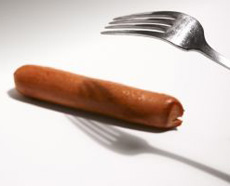
 Organic or regular: big difference! Photo by Sarah Lewis | SXC.
|
STEPHANIE ZONIS focuses on good foods and the people who produce them.
|
|
September 2006
Updated June 2009
|
 |

Organic Hot Dogs Vs. Conventional Hot Dogs
Page 2: How Hot Dogs Are Made
Click here to read other Organic Matter columns
This is Page 2 of a six-page article. Click on the black links below to visit other pages.
A little background is in order here. What exactly goes into a hot dog? The Federal Standards of Identity tell us that a hot dog (a.k.a. frankfurter or wiener) is a link-shaped, cooked and/or smoked sausage.
- A hot dog contains meat, fat, water (sometimes in the form of ice chips), and spices, including salt. The meat can be all beef or a blend.
- The finished hot dogs cannot contain more than 30% fat nor more than 10% added water, or a combination of 40% fat and added water. Non-meat binders or extenders (such as nonfat dry milk, cereal, or dried whole milk) or isolated soy protein may be added, but not more than 3.5% of the former or 2% of the latter; and where either is added the ingredient label on the product must indicate this.
- Hot dogs are cooked in a casing, or thin skin, to keep their shape. A skinless hot dog is one in which the manufacturer has removed the casing prior to sale. The casing may have been cellulose (vegetable material) or natural, made from animal intestine. Casings are edible, although many people don’t like the extra texture. If the hot dog has a casing, the package label must state if the casing is of a different species than the meat it’s made of (for example, a pork casing on a beef hot dog).
- Up to 15% of a hot dog can be so-called “variety meats” such as heart, kidney, or liver; again, if a hot dog includes these, the label must say so.
- There are also ingredients in very small quantities such as corn syrup, the artificial sweetener sorbitol, ascorbic acid (vitamin C), and corn and wheat gluten protein (these are binders which hold water and lessen costs for manufacturers).
- Then, there are the colorings, maintainers, and preservatives, such as sodium lactate (an inhibitor of pathogens), sodium diacetate (also inhibits the growth of bacteria), sodium phosphate (the salt of a phosphoric acid used to bind water to meat), sodium erythorbate (along with ascorbic acid, this increases the speed of the nitrite reaction in the curing process), nitrates (potassium and sodium), and sodium nitrite.
- Although many people can bring themselves to ignore the rest of the sometimes-questionable list of ingredients in a hot dog, sodium nitrite and nitrates get everyone’s attention in a way you don’t want if you’re a hot dog manufacturer.
Organic hot dogs, on the other hand, are all-natural, have no fillers, preservatives, variety meats, nitrites or other preservatives. Read more about them in the Organic Hot Dogs section.
Here’s the answer to why the number of hot dogs per package don’t match the number of rolls per package:
Initially, hot dogs, as sausages, were sold in butcher shops by the pound. Hot dog bun manufacturers independently began to package eight rolls together. In 1940, when first began to package hot dogs, they chose to sell them by the pound, which yielded ten pieces. That’s logical; as to why the bread manufacturers didn’t add another two buns to their packages is not. Perhaps a consumer write-in campaign might help.
Continue To Part 3: Nitrates & Nitrites
Go To Article Index Above

|




 Organic or regular: big difference! Photo by Sarah Lewis | SXC.
Organic or regular: big difference! Photo by Sarah Lewis | SXC.